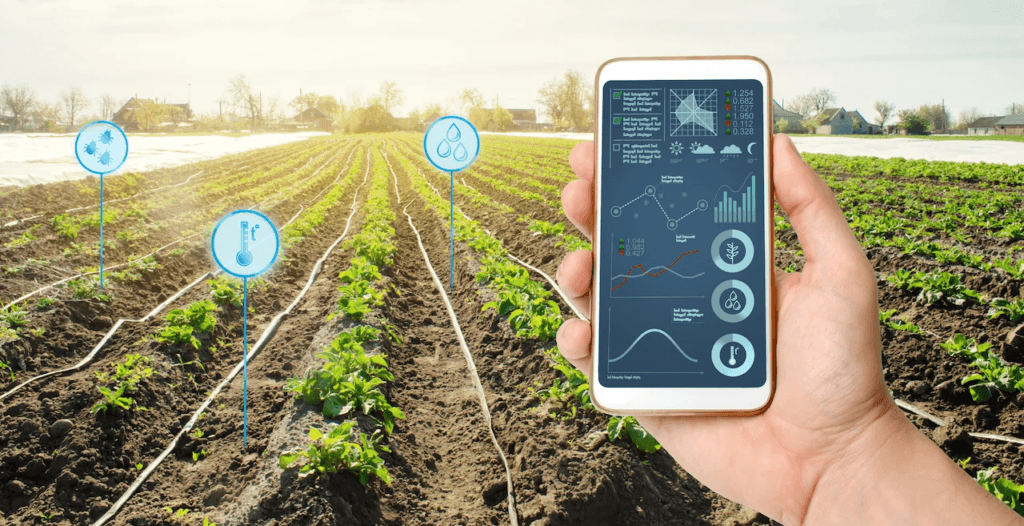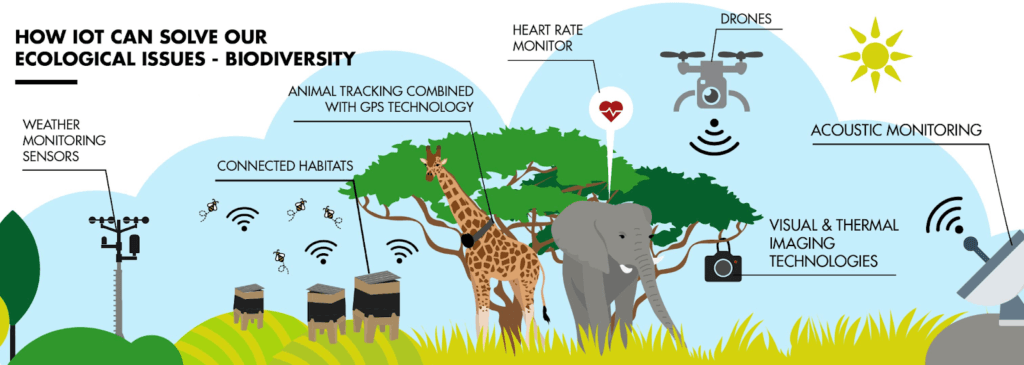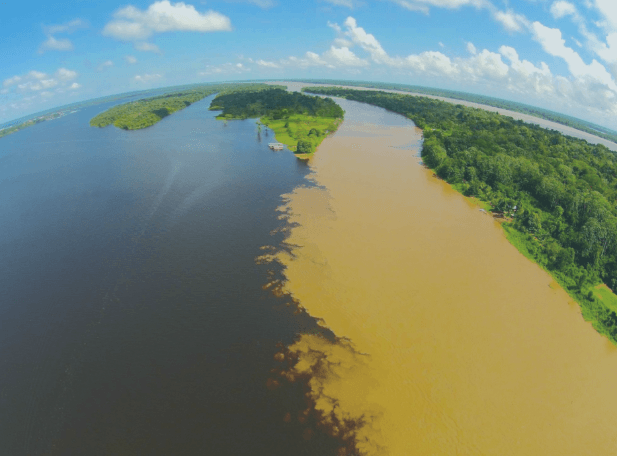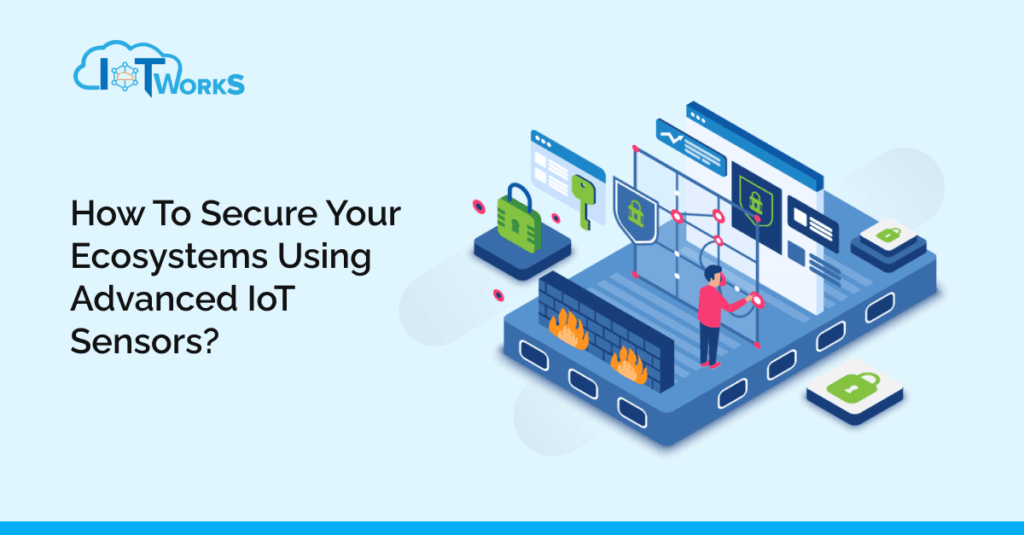In today’s rapidly evolving technological landscape, the rise of IoT (Internet of Things) has revolutionised how we monitor and secure ecosystems. Whether it’s managing agricultural lands, urban environments, or industrial facilities, IoT sensors offer unprecedented capabilities to ensure the security and sustainability of these ecosystems.
According to a report by Statista.com, the number of IoT-connected devices is expected to reach 30.9 billion by 2025, highlighting the growing adoption of this technology across industries. As the need for real-time monitoring and data-driven decisions increases, IoT sensors have become essential in mitigating risks, ensuring efficiency, and enhancing security.
How IoT Sensors Work in Securing Ecosystems

An IoT sensor works as a device that collects information from the surroundings and forwards it to some central system for analysis. Such sensors could track anything from air quality, temperature, humidity, and soil conditions to identifying physical movements and even vibrations.
The AI-powered platform analyses this information collected and provides actionable insight in real-time, thereby giving an organisation the chance to respond immediately to any threats or inefficiencies detected.
Key Benefits of Using IoT Sensors for Ecosystem Security

IoT sensors are revolutionising ecosystem security by providing real-time data to monitor and protect natural environments. Now, let’s explore the key benefits of using IoT sensors for enhancing ecosystem security.
1. Real Time Monitoring
One major advantage of IoT is its superiority in the monitoring of the environment through sensors. For example, sensors installed on an ecosystem continuously collect information, which is then processed and analysed for threats or irregularities. In agriculture, for example, using sensors can monitor soil moisture conditions and alert farmers to optimum conditions, thus preventing crop failure.
2. Automated Responses
IoT sensors can autonomously trigger responses depending on certain criteria. For example, if there is an unusual spike in temperature detected by a sensor at a factory, the system can automatically shut off the machinery to prevent overheating. Also, IoT sensors can track shifts in water levels in areas prone to flooding, and can indicate if a disaster is likely to occur by alerting the authorities beforehand.
3. Enhanced Security with Motion Detection
IoT sensors can identify unauthorised access or intrusion when installed in an industrial setting or natural reserve. Sophisticated IoT sensors with machine learning capabilities can differentiate between different kinds of motions, whether it is motion by a human being or an animal, hence lowering the chances of false alarms.
4. Predictive Analytics
With IoT sensors collecting data indefinitely, it eventually becomes easier to predict whatever issues might come before they worsen. In the environment monitoring, predictive analytics can give advance warning of natural disasters such as wildfires or floods, allowing for time to take preventative measures.
5. Scalability and Flexibility
IoT sensors are scalable. Be it a small farm or even a huge industrial complex, IoT networks can scale up to match your requirements. Wireless sensors allow flexibility in positioning with total assurance that the critical areas would be covered without the need for heavy infrastructure.
6. Cost Effectiveness
IoT sensors help reduce the extent of human intervention through automation of monitoring and response processes. This saves cost as well as costly repairs and allows IoT systems to provide predictive maintenance in minimising downtime in industrial setups.
Applications of IoT Sensors in Ecosystem Security
Let’s explore the applications of IoT Sensors in ecosystem security and how they are revolutionising environmental monitoring and protection.
1. Agriculture
Techniques in smart farming involve the use of sensors in monitoring soil conditions and weather patterns and crop health. This information provides the farmer with decisions on proper usage of water and fertilisers and guarantees safety and productivity of crops. IoT-enabled drones also investigate vast agricultural lands to give real-time data concerning pest infestation and crop health.
2. Urban Environments
IoT sensors can be deployed around the city to measure air quality, noise pollution, and water quality, all of which are significant factors in making better urban places as well as in sustainability. Beyond environmental monitoring, there are IoT sensors applied in smart traffic systems that optimise traffic flow and prevent congestion, thereby making urban transportation systems safer and more effective.
3. Industrial Sites
IoT sensors play a central role in the protection of industrial ecosystems, especially in hazardous materials and critical infrastructure use. Sensors can inspect whether a bridge’s structural element is intact, if a pipeline has leakage, and if a power grid is free from electrification.
4. Wildlife and Natural Reserves
Wildlife and natural ecosystems are protected using IoT sensors. These sensors help detect animal movement, monitor environmental conditions, and detect poaching activity. Using these remote-operating sensors, data can be transmitted over long distances as well.
Challenges and Considerations in Implementing IoT Sensors
While IoT sensors offer numerous benefits, deploying them for ecosystem security is not without some associated challenges:
1. Data Security and Privacy
It is equally true that connected systems such as IoT sensors are vulnerable to cyber-attacks. Ensures encryption and secure transmission of data.
2. Initial Costs
Even though IoT sensors mean long-term cost savings in the operational aspect, the infrastructure expenses could come at a greater cost at the beginning and would be really something that large organisations might easily be capable of funding as compared to smaller ones.
Best Practices for Securing Ecosystems with IoT Sensors
Let’s explore some best practices for securing ecosystems with IoT sensors, ensuring robust protection against potential vulnerabilities.
1. Choose the Right Sensors for Your Needs
Not all IoT sensors are the same. Depending on your network, you may need certain temperature or motion sensors, air quality, or some other variables in your environment. Ensure you select the right sensors depending on what your business needs in the process.
2. Use Secure Communication Protocols
Secure communication protocols must be employed to prevent breach of data. For that, it is essential to use such protocols that have been developed for IoT networks such as MQTT or CoAP.
3. Leverage Cloud and Edge Computing
Cloud computing can also store high volumes of data accumulated by IoT sensors, but coupled with edge computing, it reduces data processing and response times significantly, especially in applications such as disaster prevention.
4. Regular Maintenance and Updates
IoT sensors require regular maintenance to ensure they function properly. Furthermore, software updates will prevent you from becoming a victim of emerging cyber threats, meaning your sensors will run effectively.
Embrace IoT Sensors to Secure Your Ecosystems

IoT becomes more integral in playing a key role for ecosystem security. Advanced sensors in IoT deliver real-time monitoring, automated responses, and predictive analytics, ensuring that ecosystems are secured efficiently and cost-effectively.
With such implementations, organisations are able to protect their environments and improve ROI with higher efficiency and lower cost of operations.
Are you ready to safeguard your ecosystems through the most advanced IoT technology? Contact IoT-WorkS and discover how we can facilitate the implementation of IoT sensors tailored to your specific needs.
FAQ
1. How can IoT sensors help secure ecosystems? IoT sensors monitor environmental changes in real-time, detect threats like pollution or illegal activities, and provide data to enhance conservation efforts.
2. What kind of data do IoT sensors collect for ecosystem security? IoT sensors collect data on air quality, water levels, temperature, wildlife movement, and other environmental factors to ensure timely responses to potential threats.
3. Are IoT sensors effective in remote or hard-to-reach ecosystems?
Yes, IoT sensors are highly effective in remote areas, allowing continuous monitoring and alerting authorities without the need for constant human intervention.
